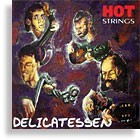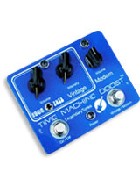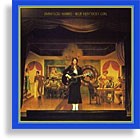
Randall Aiken makes his home in Buford, Georgia, and for many years has been repairing and designing amps.
A double-degree holding electrical engineer who put himself through college by fixing and modifying guitar amps and playing guitar in bar bands, Aiken is quite familiar with the vagaries of guitar tone. His current line includes three amps, with several others in the works.
Aiken’s Invader amp is available as an 18-watt or 30-watt in separate head or combo with 1×12″ or 2×12″ configuration that looks like a cross between a Dumble and a Marshall head, but with a few cool tricks.
The Invader is robust: built on 1/8″ FR4 turret boards silkscreened with component-reference designators for ease of troubleshooting and repair, hand-wired to chassis-mounted sockets and pots.
“We use mil-spec RV4 sealed potentiometers for the front panel controls, two-watt carbon-film resistors or two-watt metal film resistors where appropriate for lowest noise, and five-watt metal-oxide power resistors,” Aiken said. “All of our coupling capacitors are 630-volt polypropylene film/foil axial-leaded construction, and we use 500-volt silver mica capacitors for the small values in the picofarad range, like the treble capacitor in the tone stack. The power supply filter capacitors are the standard large 50uF/50uF 500-volt dual chassis-mounted capacitors similar to the old LCR types used in older Marshall amplifiers.”
Rear-panel pin jacks facilitate tube biasing without removing the chassis, using a rear-panel bias pot. Tube sockets for preamps are shielded Belton glass-fiber-filled PPS, with wrap-around pins for reliability. Output-tube sockets are ceramic in EL84 amps or Belton glass-fiber-filled PPS octals in EL34 amps. All Aiken chassis are zinc-plated steel, and front and rear panels are gold anodized aluminum or (on plexi-looking units) reverse-engraved/filled polycarbonate.
The Invader also has a built-in power attenuator that lets you crank the preamp and power tubes as high as you wish, setting the master volume to an appropriate level for stage, studio, bedroom, etc. The reverb feature of this amp is, um… swell! A depth and swell control permits users to decide how much reverb they want and, how fast or slow the reverb tails off. This feature allows players to get an almost “plate reverb” decay that’s impossible with conventional spring reverb units. It’s silky smooth and feels like a combination of plate and spring. Hard to describe, but lovely to hear.
And, all of Aiken’s amps have voltage selector switches on their rear panels, which allow for the use of 100, 120, 200, 220, 230, and 240 volts at 50 or 60Hz. That means the amps can be used anywhere in the world. They also have a matching rear-panel impedance selector switch that allows for use with 4-, 8-, or 16-ohm speakers/configurations. Cabinets are fingerjointed birch, with tolex applied meticulously for a cornerless “vintage” look. The nameplate is engraved and filled brass, and the reverb tanks are Accutronics units.
I used the Aiken Invader and matching 2×12″ cabinet on a gig in a very large room. I plugged my G&L Legacy straight into the amp, and it was immediately obvious that is a powerful unit. In fact, I used the attenuator to drop the power – a lot! Even then, the amp emitted full-on rhythm sounds and fat solo tones. The extra dwell knob for reverb works very well for setting a long tail that doesn’t get mushy on rhythm parts.
I was surprised at the Invader’s ability to change tone at the turn of the guitar’s volume. With the Legacy on 5, rhythm parts sounded like a Twin Reverb with a closed back cabinet – plenty of bass, but not a boomy tone. Turn the knob to 10 and it was like an early-’70s 50-watt Marshall – a powerful bark on lead tones! I played a James Burton Tele during our Elvis medley, and the only thing missing was a little slap back delay.
Late in the gig, I returned to my Digitech RP-300. Some in the crew said my playing through the RP sounds like a “cassette copy” of my guitar. But through the Aiken, they “could hear the real Riley playing!”
Aiken Invader 30 amplifier
Features All-tube circuit with EL34/EL84 capability, mil-spec components, built-in attenuator, two independently voiced/internally-jumpered channels, universal voltage selection, available in a 1×12 or 2×12 speaker format, or as a separate head.
Price $2,195 to $2,595.
Contact Aiken Amplification, 5044 B.U. Bowman Drive, Suite 101 Buford, GA 30518, phone (678) 714-6476, www.aikenamps.com.
This article originally appeared in VG‘s Sep ’04 issue. All copyrights are by the author and Vintage Guitar magazine. Unauthorized replication or use is strictly prohibited.



